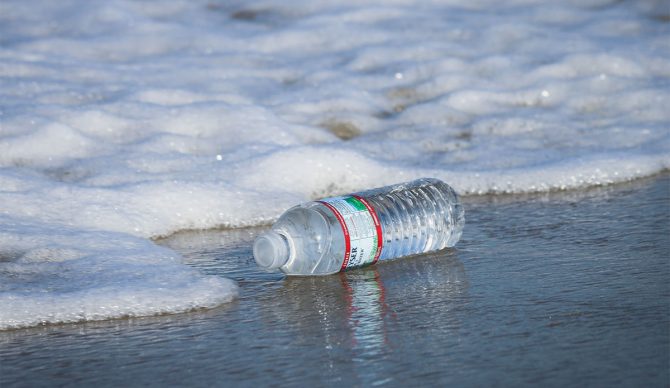
This should be there. But if you find it, don’t drink from it. Photo: Unsplash
When you’re hot and thirsty, you should drink water. But when you’re hot and thirsty and your plastic bottle has been sitting in the sun, you should not drink that water. It may seem obvious (and taste obvious), but a new study investigating what happens to plastic water bottle exposed to sunlight is something anyone who drinks water should be aware of.
I’m in the process of building an addition on our house. We’re at the foundation stage — we just poured the footings on Monday — so I’ve been spending more time than usual digging in the dirt under the beating sun. Since I am a responsible adult, I make sure I’m replacing all the fluid dripping from my brow with water. On Sunday afternoon, I was very, very thirsty. There was a plastic bottle half full of water sitting on the table saw, so I took a big swig from it. It had been sitting there all day in the sun, and it tasted like it had been sitting there all day in the sun. Which is to say it tasted like the plastic water bottle — and that’s because the water was infused with it.
In the recent study, which was published in the journal Eco-Environment & Health, scientists exposed six different kinds of plastic water bottles to ultraviolet-A and sunlight. What they found was alarming: those rays degraded the bottles, which create volatile organic compounds (VOCs).
“Volatile organic compounds are emitted as gases from certain solids or liquids,” the EPA explains. “VOCs include a variety of chemicals, some of which may have short- and long-term adverse health effects. Concentrations of many VOCs are consistently higher indoors (up to ten times higher) than outdoors. VOCs are emitted by a wide array of products numbering in the thousands. Examples include: paints and lacquers, paint strippers, cleaning supplies, pesticides, building materials and furnishings, office equipment such as copiers and printers, correction fluids and carbonless copy paper, graphics and craft materials including glues and adhesives, permanent markers, and photographic solutions.”
Clearly, those are all things that we should not be ingesting. Because of the amount of plastics that we create and use on a daily basis, though, we are. Plastics and plastic compounds are found just about everywhere, including our blood.
“Our findings provide compelling evidence that plastic bottles, when exposed to sunlight, can release toxic compounds that pose health risks. Consumers need to be aware of these risks, especially in environments where bottled water is exposed to sunlight for prolonged periods,” Dr Huase Ou, lead researcher from the Guangdong Key Laboratory of Environmental Pollution and Health at Jinan University in China, said in a statement.
One or two sips, however, isn’t going to kill you, but the researchers did find that they tend to accumulate in our bodies.
“Considering the average weight of a container (approximately 20 grams), the amount of VOCs volatilized from a single container was only a few nanograms. Consequently, even after long-term exposure, opening and consuming water from a bottled container poses minimal health risks to humans,” the study authors wrote.
The bottles they used for testing were chosen because they were made from one of the most widely available types of plastic. Polyethylene terephthalate (PET) is found in just about everything plastic these days, but the bottles had different concentrations of it. Depending on how the bottles were made and what kind of adhesives were used to make it all stick together, the VOCs leeched out at different rates.
We’ve known for some time now that sunlight degrades plastic — it’s a process called photodegradation — but the staggering amount of plastic we use every day is creating a pretty big problem, both for our health and the health of the planet.

